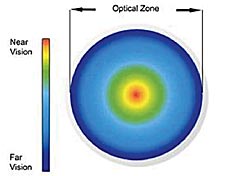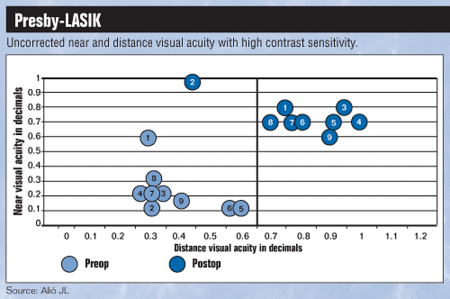Presby-LASIK holds promise for young presbyopes
An initial period of blurred distance vision is common after the procedure, researcher says.
![OSN at ESCRS [logo]](/~/media/images/news/print/ocular-surgery-news-europe-asia-edition/2006/01_january/osnatescrs_150_65_6173.gif) LISBON — A multifocal LASIK procedure shows promise for correction of presbyopia in relatively young presbyopic patients, according to two surgeons experienced with the technique.
LISBON — A multifocal LASIK procedure shows promise for correction of presbyopia in relatively young presbyopic patients, according to two surgeons experienced with the technique.
José Ruiz Colecha, MD, presented results of a study comparing results with the technique, called presby-LASIK, to results with pseudoaccommodating and accommodating IOLs.
“Presby-LASIK has got a great potential,” Dr. Colecha told attendees at the European Society of Cataract and Refractive Surgeons meeting here.
In the study, uncorrected distance and near visual acuities were recorded preoperatively and postoperatively, and best corrected distance and near visual acuities were recorded preoperatively. The data for both UCVA and BCVA were plotted together on a graph designed by the Vissum Institute in Alicante, Spain.
The study Dr. Colecha presented included 44 eyes of 22 patients that underwent presby-LASIK, 28 implanted with a pseudoaccommodating IOL and 14 implanted with an accommodating IOL.
According to the results, the presby-LASIK eyes showed improvement in distance visual acuity and what he called a “variable improvement” for near vision.
The pseudoaccommodating IOLs had “varying” performance, he said, with some lenses showing good results for near vision but not for distance and some the opposite.
“The results so far for the pseudoaccommodative lenses are not encouraging because of great variability in the outcome,” Dr. Colecha said.
The accommodating IOL demonstrated “stable” performance for both distance and near vision, and so shows promise for correction of presbyopia, Dr. Colecha said.
 |  |
In presby-LASIK correction, a central 3-mm zone (left) for near vision is created, surrounded by a transition zone for intermediate vision and a 6-mm optical zone (right) for distance vision. Image: Alió JL | |
Plotting near and distance
Although the study included IOL patients, Dr. Colecha’s presentation concentrated mostly on the results with the presby-LASIK procedure.
He explained that the goal of presby-LASIK is to create a central 3-mm optical zone on the cornea with an add of +0.75 D to +2 D for near vision. This is surrounded by a transition zone for intermediate vision and an optical zone of at least 6 mm for distance vision.
In an e-mail message, Jorge L. Alió, MD, PhD, the medical director of the Vissum Institute and the lead researcher in this study, said that most young presbyopes require only an addition of 1.75 D of near vision to see at J1, but older presbyopes usually have passed beyond that stage, making the procedure less effective for them.
In this study, the mean age of the patients who underwent presby-LASIK was 58 years, ranging from 51 to 68. The mean preoperative sphere was 2.13 D, ranging from 3.25 D to 0.75 D, and the mean preop cylinder was –0.58 D. These were reduced to a mean sphere of –0.17 D and mean postop cylinder of –0.44 D at 6 to 12 months postop.
The data were plotted on a graph that presented distance and near vision on the horizontal and vertical axes to show the change from preop to postop. (See accompanying figures.)
The upper right quadrant represents a state of near “perfect,” spectacle-free vision for near and far, while the lower left represents a poor outcome for both near and far vision, Dr. Colecha said.
He showed nine of the 22 presby-LASIK patients plotted on this graph. Almost all the patients moved from the lower left preoperatively to the upper right after undergoing presby-LASIK.

Neural adaptation
Dr. Colecha said there is a period of neural adaptation for some patients after presby-LASIK correction. Because near and far images are focused simultaneously on the retina, the brain must adapt to this new way of seeing things and learn to select the object of interest, whether near or far.
Over time, the defocused image will become neutralized through neural adaptation in the visual cortex, he said.
When presbyopic patients have been wearing bifocal or multifocal spectacles or weighted bifocal contact lenses, this neural adaptation after presby-LASIK may be challenging, Dr. Colecha said. Bifocal spectacles provide and abrupt change from the near zone to the far zone, from which the patient can select.
After presby-LASIK, there can be a period of blurred distance vision that usually lasts between 3 and 4 weeks, he said. This phase is part of the neural adaptation to simultaneous near and far vision.
Dr. Colecha said that one of the take-home messages of his talk was that ophthalmologists should avoid previous bifocal spectacle wearers when selecting patients for presby-LASIK.
“They are used to having very good near vision with spectacles,” he said.
He acknowledged the need for improvements to the presby-LASIK software.
“With more developments in the software, this method will be the future for the young presbyope,” he said.
For Your Information:
- José Ruiz Colecha, MD, and Jorge L. Alió, MD, PhD, can be reached at Vissum, Insituto Oftalmológico de Alicante, Avda. De Denia, s/n, 03016 Alicante, Spain; +34-965-150-025; fax: +34-965-151-501; e-mail: jlalio@vissum.com.
- Jared Schultz is an OSN Staff Writer who covers all aspects of ophthalmology. He focuses geographically on Europe and the Asia-Pacific region.
